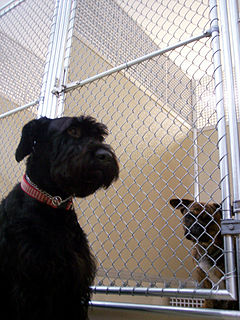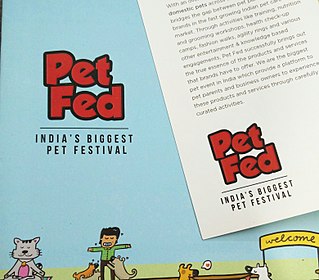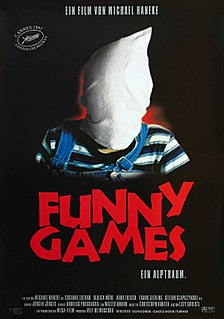 W
WBitch is a pejorative slang word for a person, usually a woman. When applied to a woman or girl, it means someone who is belligerent, unreasonable, malicious, controlling, aggressive, or dominant. When applied to a man or boy, bitch reverses its meaning and is a derogatory term for being subordinate, weak, or cowardly.
 W
WCropping is the removal of part or all of the external flaps of an animal's ear. The procedure sometimes involves bracing and taping the remainder of the ears to train them to point upright. Almost exclusively performed on dogs, it is an old practice that was once done for perceived health, practical or cosmetic reasons. Veterinary science states there is no medical or physical advantage to the animal from the procedure, leading to concerns of animal cruelty over performing unnecessary surgery on animals. In modern times, cropping is banned in many nations, but is still legal in a limited number of countries. Where permitted, it is seen only in certain breeds of dog, such as the Pit bull, Doberman Pinscher, Schnauzer, Great Dane, Boxer and Cane Corso.
 W
WDog daycare, often known as "doggy daycare", refers to a short-term daytime care for dogs. It fills a niche between multi-day kennel boarding and pet sitting, where the sitter comes to the pet's home. It shares many similarities with a regular daycare for children, with the exception being that a dog daycare is for canines. The two share the same philosophy. Parents, or in the case of the dog daycare, owners, have a busy schedule and the often prolonged hours at work drastically reduce the time that could be spent with their children or pets.
 W
WA diabetic alert dog is an assistance dog trained to detect high (hyperglycemia) or low (hypoglycemia) levels of blood sugar in humans with diabetes and alert their owners to dangerous changes in blood glucose levels. This allows their owners to take steps to return their blood sugar to normal, such as using glucose tablets, sugar and carbohydrate rich food. The dog can prompt a human to take insulin.
 W
WThe Dog Aging Project is a long-term biological study of aging in dogs, centered at the University of Washington. Professors Daniel Promislow and Matt Kaeberlein are the co-directors of the project. Together with Chief Veterinarian, Dr. Kate Creevy, the project primarily focuses on research to understand dog aging through the collection and analysis of big data. Additionally, there is a small component of the project that explores the use of pharmaceuticals to potentially increase life span of dogs. The project has implications for improving the life spans of humans and is an example of geroscience.
 W
WA dog bite is a bite upon a person or other animal by a dog; especially from a rabid dog. More than one successive bite is often called a dog attack, although dog attacks can include knock-downs and scratches. Though many dog bites do not result in injury, they can result in infection, disfigurement, temporary or permanent disability, or death. Another type of dog bite is the "soft bite" displayed by well-trained dogs, by puppies, and in non-aggressive play. Dog bites can occur during dog fighting, as a response to mistreatment, trained dogs acting as guard or military animals, or during a random encounter.
 W
WIn common with many of the expeditions of the Heroic Age, Douglas Mawson's Australasian Antarctic Expedition (AAE) employed dog-hauled sledges as a principal means of transportation during exploration of the continent. Dog sledges could carry more weight and travel faster than man-hauled sledges; they were more reliable in the freezing temperatures than motor-sledges; and dogs had proved to be more adaptable to harsh Antarctic conditions than ponies.
 W
WHuman–canine bonding is the relationship between dogs and humans. This bond can be traced back at least 15,000 years to the Bonn-Oberkassel dog that was found buried with two humans. For centuries, dogs have been labeled as "man's best friend," offering companionship and loyalty to their human counterparts. This is evident in most homes where dogs are domesticated. Children and adults have cordial relationships with all types of dogs.
 W
WA dingo–dog hybrid is a hybrid cross between a dingo and a domestic dog. The current population of free ranging domestic dogs in Australia is now probably higher than in the past. However, the proportion of the so-called "pure" dingoes has been on the decrease over the last few decades due to hybridisation and is regarded as further decreasing.
 W
WA kennel is a structure or shelter for dogs or cats. Used in the plural, the kennels, the term means any building, collection of buildings or a property in which dogs or cats are housed, maintained, and bred. A kennel can be made out of various materials, the most popular being wood and canvas.
 W
WThe Lychee and Dog Meat Festival is an annual festival held in Yulin, Guangxi, China, during the summer solstice in which festival goers eat dog meat and lychees. The festival began in 2009 and spans about ten days during which thousands of dogs are reportedly consumed. The festival has drawn criticism both domestically and abroad.
 W
WMy Life in Dog Years is a non-fiction book for children written by the American author Gary Paulsen, together with his wife, Ruth Wright Paulsen. It was published first by Delacorte Press in 1997.
 W
WThe origin of the domestic dog includes the dog's genetic divergence from the wolf, its domestication, and the emergence of the first dogs. Genetic studies show that all ancient and modern dogs share a common ancestry and descended from an ancient, now-extinct wolf population - or closely related wolf populations - which was distinct from the modern wolf lineage. The dog's similarity to the extant grey wolf is the result of substantial dog-into-wolf gene flow, with the modern grey wolf being the dog's nearest living relative. An extinct Late Pleistocene wolf may have been the ancestor of the dog.
 W
WPack is a social group of conspecific canines. Not all species of canids form packs; for example, small canids like the red fox do not. Pack size and social behaviour within packs varies across species.
 W
WPet Fed is the biggest pet festival held in India, with its main editions held annually at New Delhi, Mumbai and Bengaluru. The first ever edition was organised on 1 November 2014 at Dilli Haat INA in New Delhi.
 W
WA puppy is a juvenile dog. Some puppies can weigh 1–1.5 kg (1-3 lb), while larger ones can weigh up to 7–11 kg (15-23 lb). All healthy puppies grow quickly after birth. A puppy's coat color may change as the puppy grows older, as is commonly seen in breeds such as the Yorkshire Terrier. Puppy refers specifically to young dogs, while pup may be used for other animals such as wolves, seals, giraffes, guinea pigs, rats or sharks.
 W
WRabies is a viral disease that exists in Haiti and throughout the world. It often causes fatal inflammation of the brain in humans and other mammals, such as dogs and mongooses in Haiti. The term "rabies" is derived from a Latin word that means "to rage"; rabid animals sometimes appear to be angry. Early symptoms can include fever and tingling at the site of exposure, followed by one or more of the following symptoms: violent movements, uncontrolled excitement, fear of water, an inability to move parts of the body, confusion, and loss of consciousness. Once symptoms appear, death is nearly always the outcome. The time period between contracting the disease and showing symptoms is usually one to three months; however, this time period can vary from less than a week to more than a year. The time between contraction and the onset of symptoms is dependent on the distance the virus must travel to reach the central nervous system.
 W
WRoan is a coat color found in many animals, including horses, cattle, antelope, cat and dogs. It is defined generally as an even mixture of white and pigmented hairs that do not "gray out" or fade as the animal ages. There are a variety of genetic conditions which produce the colors described as "roan" in various species.
 W
WFunny Games is a 1997 Austrian psychological thriller film written and directed by Michael Haneke, and starring Susanne Lothar, Ulrich Mühe, and Arno Frisch. The plot involves two young men who hold a family hostage and torture them with sadistic games in their vacation home. The film was entered into the 1997 Cannes Film Festival. A shot-for-shot remake, filmed and set in the United States, was released in 2007, also directed by Haneke, this time with an English-speaking cast and a mostly American crew.
 W
WTail wagging by dogs is the behavior of the dog observed as its tail moves back and forth in the same plane. Within Canidae, specifically Canis lupus familiaris, the tail plays multiple roles, this can include balance, and communication. It is considered a social signal. The behaviour can be categorized by vigorous movement or slight movement of the tip of the tail. Tail wagging can also occur in circular motions, and when the tail is held at maximum height, neutral height, or between the legs.
 W
WTaro and Jiro were two Sakhalin Huskies which survived for eleven months in Antarctica after being left behind by the 1958 Japanese Antarctic Research Expedition. Due to poor weather conditions, the expedition was unable to airlift out 15 dogs, which were left chained and with only a few days' worth of food. Of these 15, seven of the dogs died on the chain, six of them disappeared, and two, Taro and Jiro, successfully overwintered and were discovered by the next research group the following spring. The dogs became a media sensation after their discovery, and became Japanese symbols of perseverance and fortitude. Jiro remained in Antarctica and died there as a working dog in 1960; Taro was brought to Japan, where he died in 1970. Both of their bodies were taxidermied and placed on display, and several monuments to the dogs have been erected in Japan.